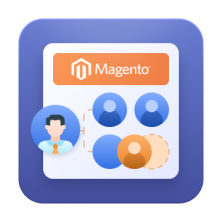Digital products are a powerful opportunity for entrepreneurs: they can be distributed instantly, require no inventory, and often generate passive income. With options ranging from eBooks to templates, discovering the best digital products to sell can significantly enhance your online business's profitability.
No matter if you're looking for trending digital products or simply want to explore the top-selling digital products available, this guide will introduce you to 15 of the best options that are both in-demand and lucrative.
What Are Digital Products?
Digital products are intangible assets, like eBooks, courses, software, graphics, digital booklets and templates, that are distributed online without physical interaction. They offer instant access upon purchase, adding convenience for users. Digital goods serve various needs, from personal development to creative design and business use.
Why Sell Digital Products?
Selling digital products offers numerous advantages:
- High Profit Margins. Digital products often have low production costs and can be sold indefinitely without incurring additional costs, maximizing profitability.
- Scalability. With digital products, you can sell to an unlimited number of customers, expanding your business potential.
- Low Overheads. Unlike physical products, there are no shipping or storage costs associated with digital goods.
- Passive Income Potential. Once created, digital products can generate passive income as they continue to sell over time.
Read More: Top 30 Side Hustles
What Makes Digital Products Better than Physical Ones?
Digital products have many advantages over their physical counterparts. The main advantage of working with digital goods is that it doesn't matter how old you are, what your educational background is, or how much money you have in your capital. The main thing is your knowledge, skills, and abilities, which can be in demand.

But that doesn't mean that you can make a fortune just by choosing any digital product and starting to sell it. If you want your customers to come back, the product must still be of value to the buyer.
Read More: A Guide to Researching What to Sell Online
Where to Sell Digital Products
Regardless of the type of digital product you create, you need an easy-to-use platform to start selling. There are various distribution methods, like selling digital products on Amazon or other online platforms that support the sale of digital products. Popular marketplaces you can rely on include:
- Etsy. Great for selling digital art, planners, and templates.
- Gumroad. Ideal for creators who want a simple setup for digital downloads and memberships.
- eBay. Suitable for reaching a large audience and selling digital downloads directly.
- Creative Market. Suitable for digital assets like fonts, templates, and graphics.
- Shopify. Excellent for those wanting a dedicated e-commerce site.
- Teachable/Thinkific. Best for those selling online courses.
Read More: 25 Best eBay ‘Killers’
15 Best Digital Products to Sell in 2025
Your first step is choosing the niche and finding popular digital products. To give you a better idea of the digital product market, here is the list of key players and their revenue in 2025:
- E-learning - $165B
- Gaming - $116B
- Music & video streaming - $77,8B
- SaaS - $77B
Below, we offer a detailed list of the top digital products to sell in 2025, complete with the pros and cons of each.
1. eBooks
eBooks continue to be popular due to their versatility. Selling eBooks is one of the most profitable digital product options because once written, they can be sold repeatedly without additional costs. eBooks on self-help, fitness, finance, and skills development tend to perform well on platforms like Amazon and Gumroad.
Pros:
- Can cover a wide range of topics.
- Low production cost with high scalability.
- Passive income potential.
Cons:
- Requires time to research and write.
- High competition in popular niches.
2. Online Courses and Workshops
The demand for online courses is steadily growing as people seek continuous learning. Platforms like Udemy and Teachable allow creators to build and sell courses on various subjects, making them one of the best digital products to sell for passive income.
Pros:
- High-value product, allowing for premium pricing.
- Opportunities for recurring revenue with course updates.
Cons:
- Requires a significant initial time investment.
- May require ongoing support or updates.
3. Planners and Templates
Planners and templates cater to individuals looking to organize their lives more effectively. These are highly popular digital products, especially among busy professionals and students. Incorporating Digital Planners into your product lineup can enhance your digital offerings, catering to the needs of those seeking efficient planning and organization tools online.
Pros:
- Easy to create and sell on platforms like Etsy.
- High demand in productivity niches.
Cons:
- Subject to high competition.
- Limited customization options can reduce appeal.
4. Design Assets and Graphics
Digital graphics, from icons to illustrations, are essential tools for online content creators. Platforms like Creative Market and Etsy are ideal for selling these top digital products. They have long-term demand as they can be repurposed across multiple projects.
Pros:
- Highly profitable if you're skilled in design.
- Useful for multiple markets, including social media managers and website owners.
Cons:
- Requires specialized design skills.
- High-quality graphics may take time to create.
5. Stock Photography
Stock photos are a great way for photographers to earn passive income. Popular stock sites like Shutterstock allow you to reach a broad audience. Niche photos, like business or lifestyle, tend to be in high demand.
Pros:
- Unlimited potential for passive income.
- High demand from websites, bloggers, and marketers.
Cons:
- Saturation in popular categories.
- Requires photography skills and quality equipment.
6. Memberships and Exclusive Content
Membership platforms like Patreon enable creators to provide subscribers with exclusive content, from articles and videos to Q&A sessions. This model builds community and offers a steady revenue stream, making it an excellent choice among digital goods to sell online.
Pros:
- Recurring revenue stream.
- Builds a loyal, engaged audience.
Cons:
- Requires consistent content updates.
- Initial marketing is required to build a subscriber base.
7. Music and Audio Tracks
Musicians and audio engineers can create and sell royalty-free tracks and sound effects. Platforms like AudioJungle make it easy to reach audiences needing audio for podcasts, ads, and more.
Pros:
- High potential for passive income through royalty-free sales.
- Appeals to a wide range of content creators.
Cons:
- Requires musical expertise.
- Competition in popular music genres.
8. Software and Mobile Apps

For those skilled in software development, creating desktop or mobile apps can be incredibly profitable. You can sell on app marketplaces or directly through a website, making it one of the most profitable digital products to sell online.
Pros:
- High earning potential.
- Fulfills specific user needs with custom features.
Cons:
- Requires advanced technical skills.
- Regular updates and customer support may be necessary.
9. Fonts and Typography Kits
Custom fonts are trending digital products, especially for designers. Sites like Creative Market make it easy for designers to list their work and reach a diverse audience looking for unique typography for branding projects.
Pros:
- High demand for custom fonts in branding.
- Once created, fonts can be sold repeatedly.
Cons:
- Requires specialized design skills.
- Market competition for unique styles.
10. Digital Art Prints
Digital art is ideal for artists looking to monetize their creations. Buyers enjoy having instant downloads they can print and frame, making these top-selling digital products popular on sites like Etsy.
Pros:
- Highly creative and customizable.
- No need for physical inventory.
Cons:
- Easy to copy, so branding is essential.
- High competition on platforms like Etsy.
11. Social Media Templates
Templates are among the best digital products to sell, especially as brands seek consistent visuals on social media. Tools like Canva make it easy to create customizable templates that sell well on platforms like Etsy.
Pros:
- In-demand from businesses and influencers.
- Helps customers save time with pre-made designs.
Cons:
- Requires design knowledge.
- Saturated market; need to create unique offerings.
12. Website Themes and Templates
Website themes, especially for WordPress or Shopify stores, are popular digital products because they save users time on development. You can sell themes on ThemeForest, tapping into an established marketplace of buyers.
Pros:
- High demand from developers and small businesses.
- Can be sold on specialized theme marketplaces.
Cons:
- Needs regular updates to keep up with platform changes.
- Requires design and coding skills.
13. Digital Marketing Resources and Toolkits
From social media calendars to email templates, digital marketing toolkits are invaluable to small businesses. These products help streamline marketing efforts and are among the best-selling digital items on platforms like Gumroad and Shopify.
Pros:
- Appeals to entrepreneurs and small business owners.
- High perceived value and easy to scale.
Cons:
- Requires marketing knowledge.
- Marketed towards a specific audience, limiting general appeal.
14. Personal Finance and Budgeting Spreadsheets
Personal finance templates help users manage their money effectively. These popular digital products are easy to create in Excel or Google Sheets and can be sold on Etsy or Shopify.
Pros:
- High demand for budgeting tools.
- Easy to create and customize.
Cons:
- Limited to a specific niche.
- May require regular updates for usability.
15. Meditation Guides and Wellness Content
Meditation and wellness guides are in-demand digital products, as people increasingly prioritize health. These products perform well on platforms like Gumroad, where creators can offer a range of content formats.
Pros:
- Increasing demand due to wellness trends.
- Can be sold in a variety of formats (audio, video, PDF).
Cons:
- High competition in wellness niches.
- Requires expertise in health and wellness.
With the right digital goods, your business can achieve profitability while helping people across the world access valuable resources instantly.
Challenges Related to Selling Digital Products
As with any other business, selling digital products may come with some challenges. Here are the most common ones and how to overcome them:

Susceptibility to Piracy and Theft
- Challenge: Digital products are vulnerable to copying, unauthorized sharing, and forgery.
- Solution: Protect your products using tools like expiring links, source code encryption, watermarks, and license key systems to deter unauthorized distribution.
Intangibility
- Challenge: Customers may hesitate to trust or value intangible products.
- Solution: Build trust by offering detailed product descriptions, customer reviews, demo versions, or free trials to showcase the product’s value.
Uneven Revenue Streams
- Challenge: Once purchased, digital products usually do not need to be re-bought, leading to inconsistent income.
- Solution: Offer subscription plans, memberships, or product bundles. Create updates, new versions, or complementary products to encourage repeat purchases.
Competition with Free Content
- Challenge: Many free alternatives can undermine the appeal of paid digital products.
- Solution: Differentiate by offering superior quality, exclusive features, excellent customer support, and added value that free alternatives cannot match.
Distribution Restrictions
- Challenge: Policies on platforms like Facebook and Instagram may prevent selling digital products directly.
- Solution: Use other channels such as your website, e-commerce platforms (e.g., Shopify, WooCommerce), or marketplaces like Gumroad or eBay. Promote your products via social media ads that direct customers to approved sales channels.
How to Sell Digital Products
Selling digital products successfully requires more than just creating a product. Here are some key steps to guide you:
- Identify Your Niche. Make sure there is demand for your product. Find out what needs it satisfies, and its utility.
- Analyze Competitors. Identify the unique features of your product based on the research findings.
- Choose Your Platform. Decide whether to sell on marketplaces like Etsy, Creative Market, or Gumroad, or directly through your own e-commerce site.
- Optimize Your Product Listings. Use clear, descriptive titles and keywords in product descriptions so potential buyers can find your products easily. Highlight the benefits and include attractive visuals.
- Set Pricing Strategically. Research similar products to price competitively. For high-value products like courses, consider tiered pricing for premium access.
- Promote Through Marketing. Leverage social media, email marketing, and influencer partnerships to reach your target audience.
- Offer Excellent Customer Support. Be responsive to customer queries and provide value with additional resources or updates to your products.
With these steps, you can start selling digital goods online effectively, reach a wider audience, and drive profitable results.
Remember to encourage customers to want to come back: offer them a system of discounts, and think about the free benefits you can offer them (a free demo, a snippet of a guide, or a book). For example, a good way to get first sales is an Early Bird discount. If you're releasing a new digital product, you can offer a 25% discount for the first 50 customers, then 10% for the next 50 customers, and then release the product at full price.
Read More: Most Profitable E-commerce Business Ideas
Wrapping Up
The digital product market presents boundless opportunities, whether you’re interested in creating content, design assets, or practical tools. From eBooks and courses to social media templates and wellness content, each digital item on this list represents a pathway to building a profitable online business.
As you choose the best digital products to sell, consider your skills, interests, and the needs of your target audience. Focus on in-demand digital products to create a sustainable and successful digital business.
Frequently asked questions
The most profitable digital products often include online courses, software, and membership subscriptions due to their high value and recurring revenue potential. These products are scalable and can cater to large audiences.
Trending digital products currently include online courses, printable templates, digital art, wellness guides, and social media templates. These products reflect a demand for self-improvement, creativity, and efficiency.
Yes, selling digital products is worth it for those looking to generate passive income with low overhead costs. Digital products have high profit margins, and once created, they can be sold indefinitely with minimal maintenance.
Templates, such as social media or budget templates, are some of the easiest digital products to create. With design tools like Canva, even beginners can create attractive, functional templates for quick sales.




















